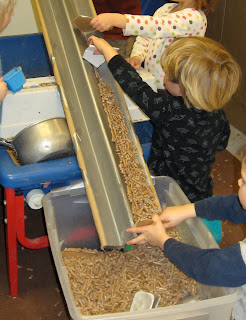Depending on the material used in the sensory table, the experience is different. Sand has its own sound and feel as it flows down the chutes. Sand also has weight. Look at this series of three pictures as Elliot and Sonja discover how a pot of sand poured down the chute feels.
The experiment begins with Elliot pouring sand down the chute from a pot. His pot is not full and he pours the sand evenly down the chute. Sonja is catching it. At this point she is only using one hand.
Next, Elliot gets a full pot of sand and now with gusto dumps the sand all at once down the chute. Sonja has switched to using two hands to hold the bowl.
What happens is that the sand races down the chute with such force that it knocks the bowl out of Sonja's hands. The result of the experiment was the pure joy of creating and feeling a force that produced an unexpected outcome.
In this set of photos, two things other than experimenting with gravity took place. One, the chute provided a physical connection between the actions of Elliot and Sonja. That naturally involved some communication---verbal and non-verbal---and some coordination of actions. In addition, there was plenty of large muscle exertion and coordination.
Look at the clip below with the same apparatus, but with a different material. Instead of sand, the table has fuel pellets.
Henry is pouring the pellets down the chute. Pellets down the chute sound different and fall at a different rate than sand. Kaisa is catching the pellets in her container. Again, there is some communication and coordination going on between them. Kaisa changes the play when she says: "Now, let me try." Pouring pellets is not as exerting as pouring sand because the weight is different. Nevertheless, Kaisa has given herself a new large muscle challenge: stretching to both pour and catch.
Besides pouring and catching there is also stopping.
Three children are stopping the pellets with cardboard dams. Children will use just about anything including their arms and hands to stop flows down the chute. Here, though, they have been provided with cardboard pieces cut in the shape of a V.
Three children are essentially doing the same action. That means a new set of communication and coordination actions. Who gets to be the one on the top, or in the middle, or on the bottom? When does the first one let the pellets pass and so on?

Besides the material sliding down the chutes, children soon discover that almost anything can slide or roll down the chutes.
CONSTRUCTION VEHICLES
SCOOPS
HOT WHEELS
There is really no end to pouring, sliding, and rolling of material and objects down the chutes.








Hi Tom- Where did you get the "pellets" that you have in the sensory table? I'd love to add them to my table as well! Thanks for the recently added video- great!
ReplyDeleteHeidi
How did ya make the chute with cardboard? I see a shiny material also?
DeleteTrying to make one for my sand table test for Tuesday!
Thanks!
Minha
Uscminha@yahoo.com
Hi Minha. I did not make the cardboard chutes. Those are packing corners from a refrigerator box. They are V-shaped and very sturdy. The shiny material is grey duct tape. I used it the length of the chutes for less friction.
DeleteI bought the wood pellets(they are fuel pellets used for heating) at Fleet Farm. Last year I bought hardwood fuel pellets at Menards. A 50 lb bag was $5-7.
ReplyDelete4